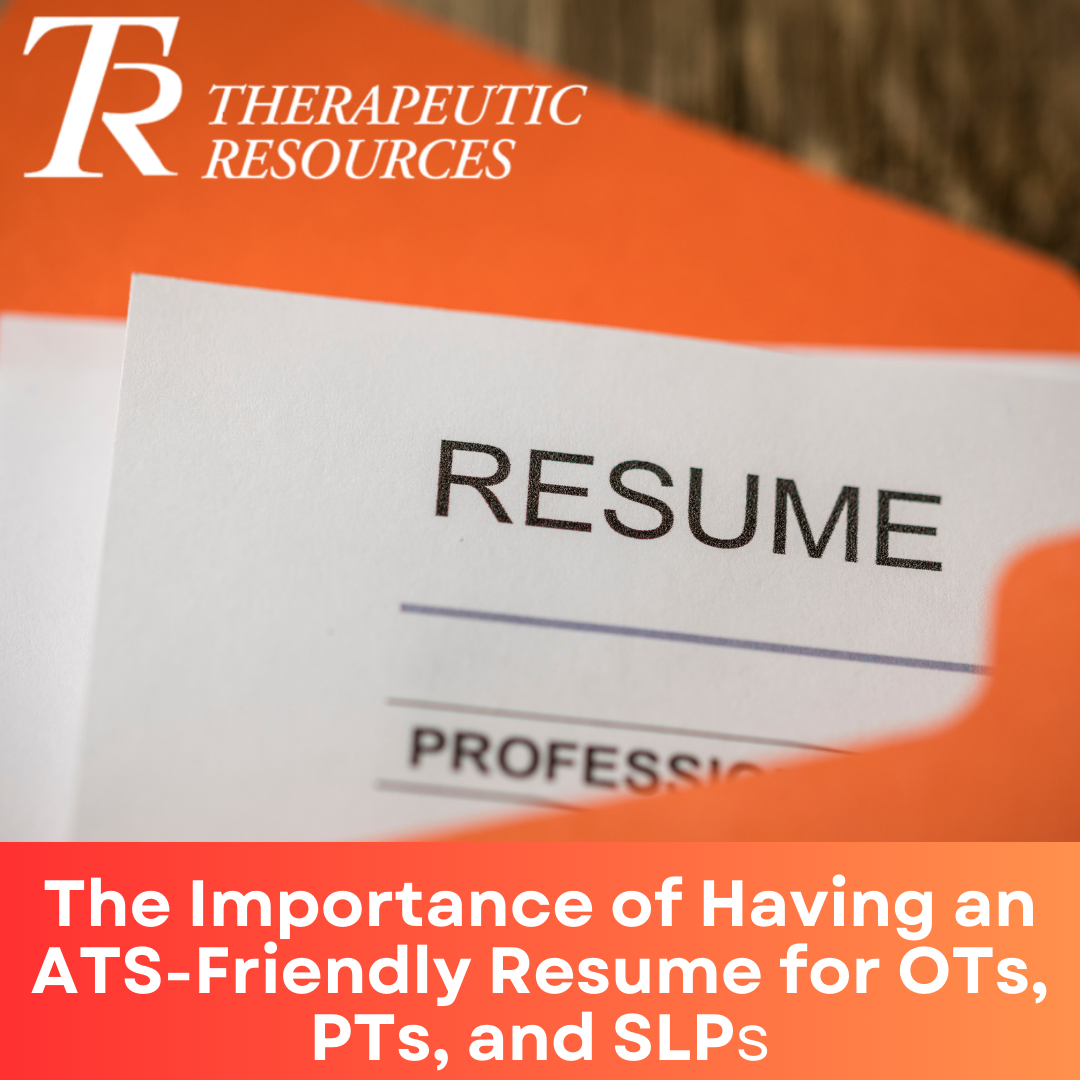« Back to Blog

The Importance of Having an ATS-Friendly Resume for OTs, PTs, and SLPs
August 26, 2024In today’s competitive job market, having a well-crafted resume is essential, especially in specialized fields like Occupational Therapy (OT), Physical Therapy (PT), and Speech-Language Pathology (SLP). However, it’s not just about having a resume that looks good on paper—it’s also about ensuring that your resume is optimized for Applicant Tracking Systems (ATS). With most resumes now being reviewed by a computerized system before they ever reach human eyes, understanding how ATS works and how to create an ATS-friendly resume can significantly improve your chances of landing your desired job. In this article, we’ll explain what ATS is and why it’s important, and offer tailored tips for OTs, PTs, and SLPs to help you stand out.
What is an Applicant Tracking System (ATS)?
An Applicant Tracking System (ATS) is software used by employers to manage the recruitment process. ATS automates the initial screening of resumes by scanning, sorting, and ranking applications based on keywords, experience, education, and other criteria set by the employer. This technology is designed to streamline the hiring process, making it easier for recruiters to identify the most qualified candidates from a large pool of applicants.
Because most resumes are first viewed by an ATS before human eyes ever see them, having an ATS-friendly resume is crucial to ensure your application makes it through this initial screening process.
Why an ATS-Friendly Resume is Crucial for OTs, PTs, and SLPs
In the fields of OT, PT, and SLP, where specialized skills and certifications are paramount, having an ATS-friendly resume is crucial. Many healthcare organizations, schools, and clinics use ATS to handle the large volume of applications they receive for therapy positions. Therefore, optimizing your resume for ATS increases the likelihood of your application being noticed by potential employers.
Tips for Creating an ATS-Friendly Resume
Here are some tailored tips for OTs, PTs, and SLPs to ensure your resume is ATS-friendly:
1. Use Relevant Keywords
ATS primarily functions by scanning for specific keywords that match the job description. To optimize your resume, carefully read the job posting and include relevant keywords related to your profession, such as “pediatric therapy,” “rehabilitation,” “patient assessment,” or “treatment planning.” Be sure to include industry-specific terms and certifications, such as “OTR/L,” “DPT,” “CCC-SLP,” or “ASHA Certified.”
2. Stick to Simple Formatting
While creative designs may look impressive, they can confuse ATS software, leading to your resume being improperly scanned or rejected. Use a clean, simple layout with standard fonts like Arial, Calibri, or Times New Roman. Avoid using tables, graphics, or text boxes, as ATS may not read these elements.
3. Use Standard Section Headings
ATS software looks for familiar section headings to categorize information. Use standard headings like “Professional Experience,” “Education,” “Certifications,” and “Skills” to ensure your resume is properly organized and easily scanned.
4. Avoid Unusual File Formats
When submitting your resume, use a file format that ATS can easily read, such as a Word document (.doc or .docx) or a PDF. While PDFs are generally ATS-friendly, some older systems may have trouble reading them, so when in doubt, a Word document is the safer choice.
5. Include Relevant Job Titles
Use the specific job title from the job posting on your resume if it accurately reflects your experience. For example, if the job title is “Pediatric Physical Therapist,” and you have that experience, make sure those exact words appear in your resume.
6. List Certifications and Licenses Prominently
In therapy professions, certifications and licenses are crucial. Ensure that your relevant credentials are prominently displayed in their own section near the top of your resume. For instance, if you’re an Occupational Therapist with an “NBCOT Certification,” or a Speech-Language Pathologist with a “CCC-SLP” credential, these should be easy to find.
7. Quantify Your Achievements
Wherever possible, quantify your achievements with specific numbers or metrics. For example, instead of saying “Improved patient outcomes,” say “Increased patient recovery rates by 25% through targeted treatment plans.” Quantifiable data is not only impressive to human readers but is often favored by ATS algorithms as well.
8. Tailor Your Resume for Each Application
Don’t use a one-size-fits-all approach. Tailor your resume for each job application by incorporating the specific keywords and requirements from the job posting. This customization increases the chances of your resume ranking higher in the ATS results.
Creating an ATS-friendly resume is essential in today’s job market, especially for specialized fields like Occupational, Physical, and Speech Therapy. With most resumes being reviewed by ATS before they reach human recruiters, optimizing your resume for this technology is crucial to ensure your application stands out.
If you’re ready to advance your career and want to ensure your resume is optimized for success, consider partnering with Therapeutic Resources. We offer expert guidance to help you craft a standout, ATS-friendly resume and connect you with the best job opportunities in your field.
To learn more and get started, send us your information here. Let us help you take the next step in your career with confidence!
